Sony VPCSB1B7E, VPCSB1Z9R, VPCSB1B9E, VPCSB1Z9E, VPCSB1Q1E Manual
...
N
User Guide
Personal Computer
VPCSB Series

n 2 N
Contents |
|
Before Use.......................................................................... |
4 |
Finding More about Your VAIO Computer .................... |
5 |
Ergonomic Considerations ............................................ |
8 |
Getting Started.................................................................. |
10 |
Locating Controls and Ports........................................ |
11 |
About the Indicator Lights ........................................... |
19 |
Connecting a Power Source ....................................... |
20 |
Using the Battery Pack................................................ |
22 |
Shutting Down Your Computer Safely ........................ |
31 |
Using the Power Saving Modes .................................. |
32 |
Keeping Your Computer in Optimum Condition .......... |
35 |
Using Your VAIO Computer.............................................. |
38 |
Using the Keyboard..................................................... |
39 |
Using the Touch Pad................................................... |
42 |
Using Special-function Buttons ................................... |
43 |
Using the Quick Web Access Function ....................... |
44 |
Using the Built-in Camera ........................................... |
46 |
Using the Optical Disc Drive ....................................... |
47 |
Using "Memory Stick".................................................. |
55 |
Using Other Modules / Memory Cards........................ |
62 |
Using the Internet........................................................ |
66 |
Using the Network (LAN) ............................................ |
67 |
Using the Wireless LAN............................................... |
69 |
Using the Wireless WAN ............................................. |
74 |
Using the BLUETOOTH Function................................ |
78 |
Using Fingerprint Authentication ................................. |
84 |
Using the TPM............................................................. |
89 |
Using Peripheral Devices.................................................. |
99 |
Connecting a Port Replicator..................................... |
100 |
Connecting External Speakers or Headphones ........ |
107 |
Connecting an External Display ................................ |
108 |
Selecting Display Modes ........................................... |
115 |
Using the Multiple Monitors Function ........................ |
116 |
Connecting a USB Device ......................................... |
118 |
Customizing Your VAIO Computer.................................. |
120 |
Selecting Performance Modes .................................. |
121 |
Setting the Password................................................. |
123 |
Using Intel(R) VT ....................................................... |
129 |
Using the VAIO Control Center ................................. |
130 |
Using the VAIO Power Management......................... |
131 |
Changing the Display Language ............................... |
132 |
Protecting Data from Unauthorized Use.................... |
133 |
Protecting the Hard Disk............................................ |
135 |

n 3 N
Upgrading Your VAIO Computer .................................... |
136 |
Adding and Removing Memory................................. |
137 |
Precautions..................................................................... |
143 |
Safety Information ..................................................... |
144 |
Care and Maintenance Information........................... |
146 |
Handling Your Computer........................................... |
147 |
Handling the LCD Screen ......................................... |
149 |
Using the Power Source ........................................... |
150 |
Handling the Built-in Camera .................................... |
151 |
Handling Discs .......................................................... |
152 |
Using the Battery Pack.............................................. |
153 |
Handling "Memory Stick"........................................... |
154 |
Handling the Built-in Storage Device ........................ |
155 |
Using Fingerprint Authentication ............................... |
156 |
Using the TPM .......................................................... |
157 |
Troubleshooting .............................................................. |
158 |
Computer Operations................................................ |
160 |
System Update / Security.......................................... |
166 |
Recovery / Recovery Media ...................................... |
167 |
Partition ..................................................................... |
171 |
Battery Pack.............................................................. |
172 |
Built-in Camera ......................................................... |
174 |
Networking (LAN/Wireless LAN) ............................... |
176 |
Wireless WAN ........................................................... |
180 |
BLUETOOTH Technology ......................................... |
181 |
Optical Discs.............................................................. |
184 |
Display....................................................................... |
189 |
Printing ...................................................................... |
194 |
Microphone................................................................ |
195 |
Speakers ................................................................... |
196 |
Touch Pad ................................................................. |
198 |
Keyboard ................................................................... |
199 |
Floppy Disks .............................................................. |
200 |
Audio/Video ............................................................... |
201 |
"Memory Stick" .......................................................... |
203 |
Peripherals ................................................................ |
204 |
Trademarks ..................................................................... |
205 |
Notice .............................................................................. |
208 |

Before Use >
n 4 N
Before Use
Congratulations on your purchase of this Sony VAIO® computer and welcome to the on-screen User Guide. Sony has combined leading-edge technology in audio, video, computing, and communications to provide you with a state-of-the-art computing experience.
!
External views illustrated in this manual may look slightly different from those of your computer.
 How to find specifications
How to find specifications
Some features, options, and supplied items may not be available on your computer.
To find out about the configuration of your computer, visit the VAIO Support web site at http://support.vaio.sony.eu/.

Before Use > |
|
Finding More about Your VAIO Computer |
n 5 N |
Finding More about Your VAIO Computer
This section provides support information about your VAIO computer.
1. Printed Documentation
Quick Start Guide — An overview of components connection, set-up information, etc.
Recovery, Backup and Troubleshooting Guide
Regulations, Guarantee and Service Support
Before activating the wireless functions such as the wireless LAN and BLUETOOTH technology, read the Regulations, Guarantee and Service Support carefully.

Before Use > |
|
Finding More about Your VAIO Computer |
n 6 N |
2. On-screen Documentation
VAIO User Guide — General information of your VAIO computer including support and troubleshooting information. To access VAIO User Guide, click Start  , All Programs, and VAIO Manual.
, All Programs, and VAIO Manual.
Windows Help and Support — A comprehensive resource for practical advice, tutorials, and demonstrations to help you learn to use your computer.
To access Windows Help and Support, click Start and Help and Support, or press and hold the Microsoft Windows key and press the F1 key.

Before Use > |
|
Finding More about Your VAIO Computer |
n 7 N |
3. Support Web Sites
If you experience any problem with your VAIO computer, launch the VAIO Care, which offers you various options to help you solve most problems. For details, see Using the VAIO Care (page 37).
If you need more assistance, visit the VAIO Support web site at http://support.vaio.sony.eu/.
When you contact VAIO Support, you will be asked for the serial number of the computer.
The serial number is a 15-digit number that can be found at the bottom of the VAIO Care window; on the bottom or the back panel of the computer; or inside the battery compartment.
Other sources for information about the VAIO computer are:
The VAIO Forum at http://club-vaio.com, which enables you to interact with other VAIO users
The VAIO web site at http://www.vaio.eu/, which offers product information
Sony Store, Online at http://www.sony.eu/store
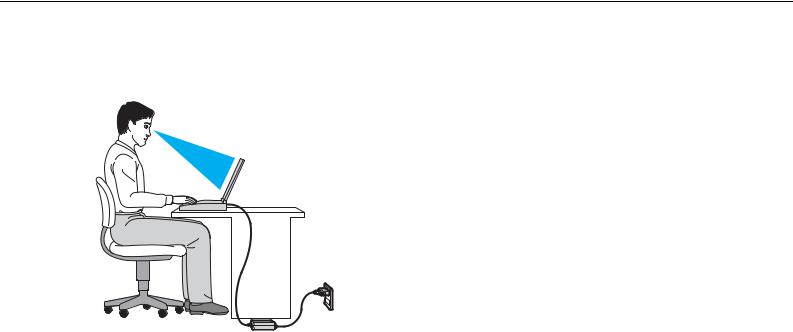
Before Use > |
|
Ergonomic Considerations |
n 8 N |
Ergonomic Considerations
You will be using your computer as a portable device in a variety of environments. Whenever possible, you should attempt to take account of the following ergonomic considerations for both stationary and portable environments:
Position of your computer – Place the computer directly in front of you. Keep your forearms horizontal, with your wrists in a neutral, comfortable position while using the keyboard or the pointing device. Let your upper arms hang naturally at your sides. Take frequent breaks while using your computer. Excessive use of the computer may strain eyes, muscles, or tendons.
Furniture and posture – Sit in a chair with good back support. Adjust the level of the chair so your feet are flat on the floor. A footrest may make you more comfortable. Sit in a relaxed, upright posture and avoid slouching forward or leaning far backwards.

Before Use > |
|
Ergonomic Considerations |
n 9 N |
Viewing angle of the computer display – Use the display tilting feature to find the best position. You can reduce eye strain and muscle fatigue by adjusting the tilt of the display to the proper position. Adjust the brightness level of the display as well.
Lighting – Choose a location where windows and lights do not cause glare and reflection on the display. Use indirect lighting to avoid bright spots on the display. Proper lighting adds to your comfort and work efficiency.
Positioning an external display – When using an external display, set the display at a comfortable viewing distance. Make sure the display screen is at or slightly below eye level when you are sitting in front of the monitor.

Getting Started >
n 10 N
Getting Started
This section describes how to get started using your VAIO computer.
!
Before starting your computer for the first time, do not connect any other hardware that did not originally come with your computer. Upon completion, connect one device (for example, a printer, an external hard disk drive, a scanner, and so on) at a time, following the manufacturer's instructions.
Locating Controls and Ports (page 11)
About the Indicator Lights (page 19)
Connecting a Power Source (page 20)
Using the Battery Pack (page 22)
Shutting Down Your Computer Safely (page 31)
Using the Power Saving Modes (page 32)
Keeping Your Computer in Optimum Condition (page 35)

Getting Started > |
|
Locating Controls and Ports |
n 11 N |
Locating Controls and Ports
Take a moment to identify the controls and ports shown on the following pages.
!
The appearance of your computer may be different from those illustrated in this manual due to variations in specifications.
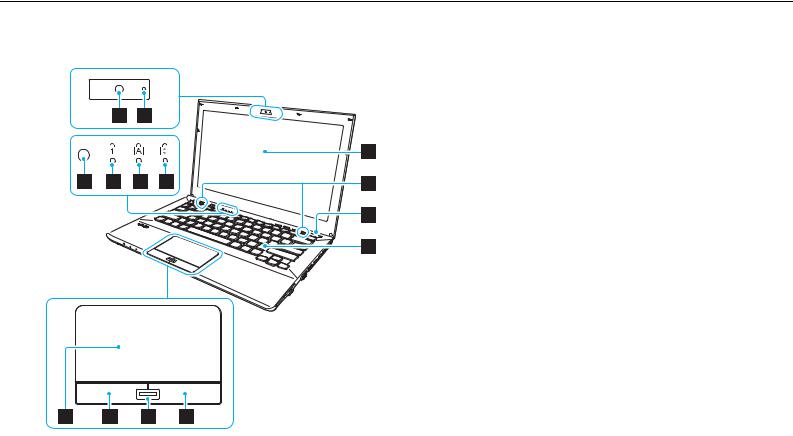
Getting Started > |
|
Locating Controls and Ports |
n 12 N |
Front |
A Built-in camera (page 46)
B Built-in camera indicator (page 19)
CAmbient light sensor (page 41), (page 192)
Measures ambient light intensity for automatically adjusting the LCD brightness to an optimum level.
D Num lock indicator (page 19)
E Caps lock indicator (page 19)
F Scroll lock indicator (page 19)
G LCD screen (page 149)
H Built-in speakers (stereo)
I Power button/Power indicator (page 19)
J Keyboard (page 39)
K Touch pad (page 42)
L Left button (page 42)
M Fingerprint sensor* (page 84)
N Right button (page 42)
*On selected models only.
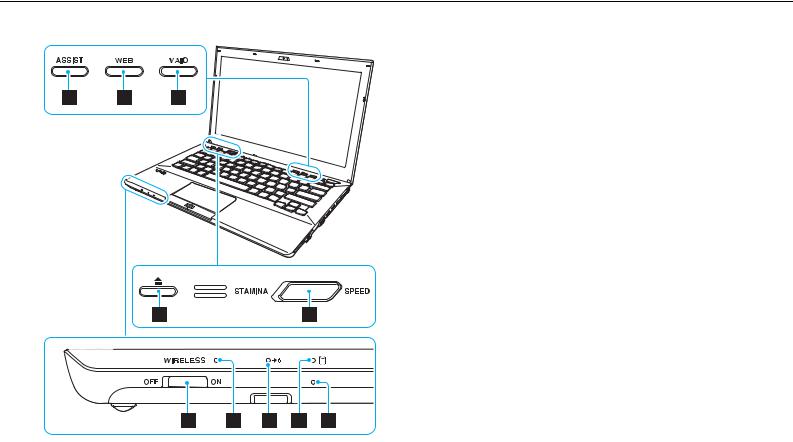
Getting Started > |
|
Locating Controls and Ports |
n 13 N |
|
A ASSIST button (page 43) |
|
B WEB button (page 43) |
|
C VAIO button (page 43) |
|
D Drive eject button (page 43), (page 47) |
|
E Performance selector switch (page 121) |
|
F WIRELESS switch (page 69), (page 74), (page 78) |
|
G WIRELESS indicator (page 19) |
|
H Charge indicator (page 19) |
|
I Disc drive indicator (page 19) |
|
J Built-in microphone (monaural) |

Getting Started > |
|
Locating Controls and Ports |
n 14 N |
Back
A Air vent
!
It is recommended that you do not use your computer with the LCD screen lid fully open for an extended period of time. If you do so, the temperature of the bottom of the unit may rise.
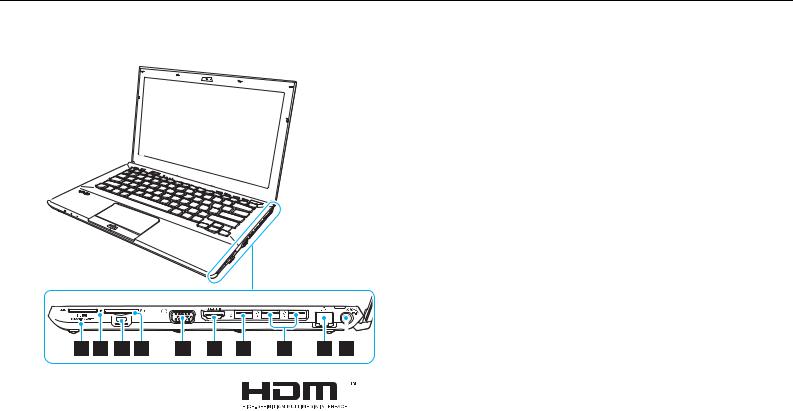
Getting Started > |
|
Locating Controls and Ports |
n 15 N |
Right
A "Memory Stick Duo" slot*1 (page 55)
B Media Access indicator (page 19)
C Security slot
D SD memory card slot (page 62)
E Monitor port*2 (page 109)
F HDMI output port*2 (page 112)
G USB port*3 (page 118)
H USB ports*4 (page 118)
I LAN port*2 (page 67)
J DC IN port*2 (page 20)
*1 |
Your computer supports only Duo-size "Memory Stick". |
||
*2 |
Not accessible when your computer is attached to the port replicator. |
||
*3 |
Compliant with the USB 2.0/3.0 standards. USB ports that are compliant |
||
|
|
|
with the USB 3.0 standard are identifiable by their blue color. |
|
|
*4 |
Compliant with the USB 2.0 standard. |
|
|||
|
|
|
|
|
|
|
|
|
|
|
|

Getting Started > |
|
Locating Controls and Ports |
n 16 N |
Left
A Headphones jack (page 107)
B Optical disc drive (page 47)
C Manual eject hole (page 184)

Getting Started > |
|
Locating Controls and Ports |
n 17 N |
Bottom (with the bottom cover)
A Air vents
B Port replicator connector cover (page 101)
C Extended battery pack connector cover*1
D Battery off button (page 26), (page 173)
E SIM card cover*2 (page 74)
F Bottom cover
*1 |
For detailed instructions on how to attach an extended battery pack, see the |
|
manual that came with your extended battery pack. |
|
While the extended battery pack is attached to your computer, be sure to |
|
keep the removed connector cover for future use. |
*2 |
On selected models only. |

Getting Started > |
|
Locating Controls and Ports |
n 18 N |
Bottom (without the bottom cover)
A Memory module (page 137)
B Battery connector (page 22)

Getting Started > |
|
About the Indicator Lights |
n 19 N |
About the Indicator Lights
Your computer is equipped with the following indicator lights:
Indicator |
Functions |
|
|
|
|
Power 1 |
Illuminates in green while the computer is in Normal mode, blinks slowly in orange while the computer is in Sleep |
|
|
mode, and turns off when the computer is turned off or enters Hibernate mode. |
|
|
|
|
Charge |
Illuminates while the battery pack is charging. See Charging the Battery Pack (page 27) for more information. |
|
|
|
|
Built-in camera |
Illuminates while the built-in camera is in use. |
|
|
|
|
Media Access |
Illuminates while data access to a memory card, such as "Memory Stick" and an SD memory card, is in |
|
|
progress. (Do not place the computer into Sleep mode or turn it off while this indicator light is lit.) When the |
|
|
indicator light is unlit, the memory card is not in use. |
|
|
|
|
Disc drive |
Illuminates while data access to the built-in storage device or the optical disc drive is in progress. Do not place |
|
the computer into Sleep mode or turn it off while this indicator light is lit. |
||
|
||
|
|
|
Num lock |
Press the Fn+Num Lk keys to activate the numeric keypad. Press the keys a second time to deactivate the |
|
numeric keypad. The numeric keypad is not active when the indicator light is unlit. |
||
|
||
|
|
|
Caps lock |
Press the Caps Lock key to type letters in uppercase. Letters appear in lowercase if you press the Shift key |
|
while the indicator light is lit. Press the key a second time to turn off the indicator light. Normal typing resumes |
||
|
||
|
when the Caps lock indicator light is turned off. |
|
|
|
|
Scroll lock |
Press the Fn+Scr Lk keys to change how you scroll the display. Normal scrolling resumes when the Scroll lock |
|
indicator light is turned off. The Scr Lk key functions differently depending on the program you are using and |
||
|
||
|
does not work with all programs. |
|
|
|
|
WIRELESS |
Illuminates while one or more wireless options are enabled. |
|
|
|

Getting Started > |
|
Connecting a Power Source |
n 20 N |
Connecting a Power Source
You can use either an AC adapter or a rechargeable battery pack for supplying power to your computer. Before using the computer for the first time, you need to connect an AC adapter to your computer.
!
Do not use your computer without installing the battery pack as it may cause the computer to malfunction.
Using the AC Adapter
While your computer is directly connected to an AC power source and has a battery pack installed, it uses power from the AC outlet.
Use only the supplied AC adapter for your computer.
To use the AC adapter
1Plug one end of the power cord (1) into the AC adapter (3).
2Plug the other end of the power cord into an AC outlet (2).
3Plug the cable from the AC adapter (3) into the DC IN port (4) on the computer.
!
The shape of the DC In plug varies depending on the AC adapter.

Getting Started > |
|
Connecting a Power Source |
n 21 N |
To disconnect your computer completely from an AC power source, unplug the AC adapter from the AC outlet. Make sure that an AC outlet is easily accessible.
If you do not intend to use your computer for an extended period of time, place the computer into Hibernate mode. See Using Hibernate Mode (page 34).
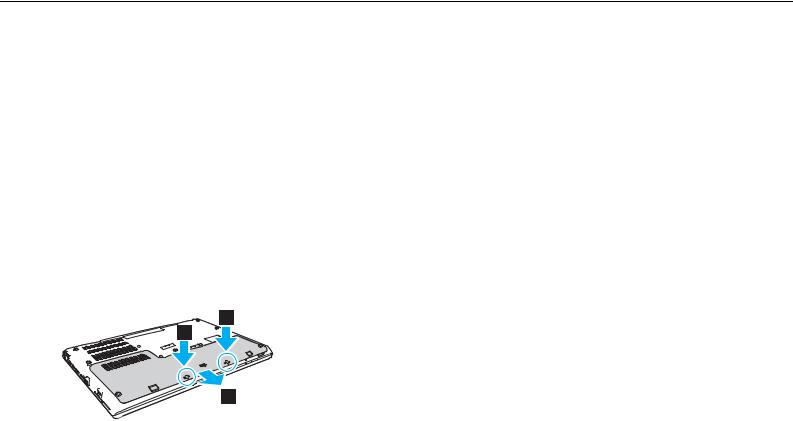
Getting Started > |
|
Using the Battery Pack |
n 22 N |
Using the Battery Pack
The battery pack is already installed on your computer at the time of delivery but is not fully charged.
!
Do not use your computer without installing the battery pack as it may cause the computer to malfunction.
Installing/Removing the Battery Pack
In order to distinguish the battery pack which is installed on your computer at the time of delivery from an extended battery pack (supplied with selected models only), it may be referred to as the primary battery pack in this manual.
For detailed instructions on how to attach and charge an extended battery pack, see the manual that came with your extended battery pack.
To install the battery pack
1Turn off the computer, close the LCD screen lid, and unplug the AC adapter if plugged.
2Unscrew the two screws (1), slide the bottom cover in the direction of the arrow (2), and remove the cover.
!
Be careful not to lose the removed screws.
Be careful not to touch the wires and the projections inside the bottom cover.
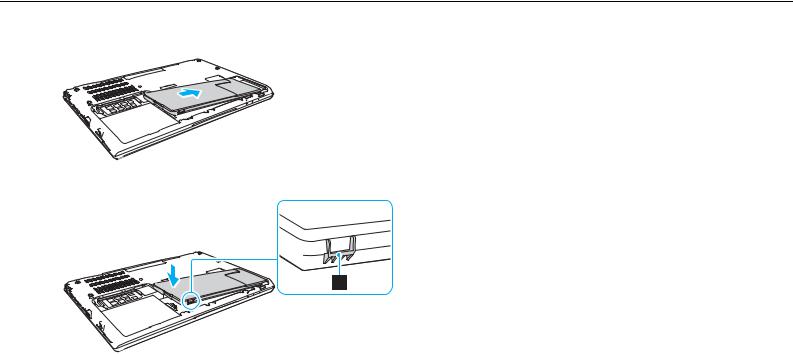
Getting Started > |
|
Using the Battery Pack |
n 23 N |
3 Slide the battery pack into the battery compartment in the direction of the arrow.
4 Push the battery pack down into the compartment until the projection (3) clicks into place.
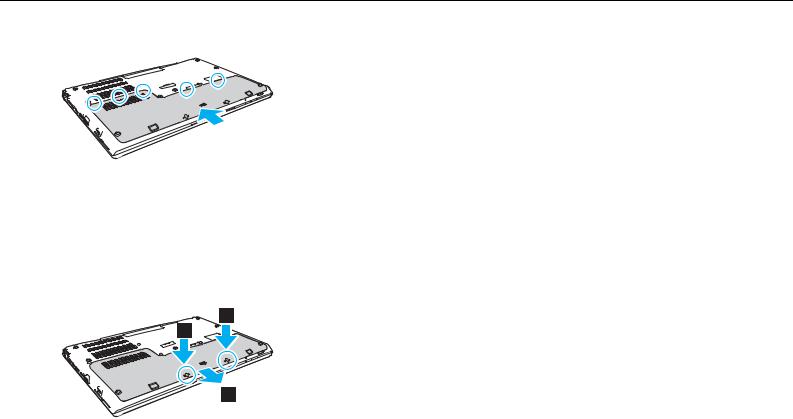
n 24 N
5 Replace the cover. Make sure all the tabs on the cover are slid in place and push the cover in the direction of the arrow.
6 Replace and tighten the removed screws.
To remove the battery pack
!
You will lose all unsaved data if you remove the battery pack while your computer is on and not connected to the AC adapter.
1Turn off the computer, close the LCD screen lid, and unplug the AC adapter if plugged.
2Unscrew the two screws (1), slide the bottom cover in the direction of the arrow (2), and remove the cover.
!
Be careful not to lose the removed screws.
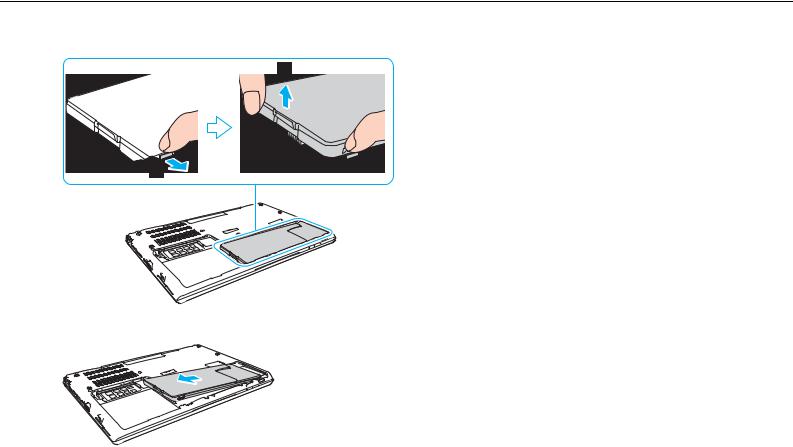
Getting Started > |
|
Using the Battery Pack |
n 25 N |
3 Pull and hold the tab in the direction of the arrow (3) and pull the battery pack in the direction of the arrow (4).
4 Slide the battery pack away from the computer in the direction of the arrow.

Getting Started > |
|
Using the Battery Pack |
n 26 N |
If your computer does not recognize the battery pack, turn off your computer and push and hold the battery off button for three seconds with a thin, straight object (such as a paper clip). If this does not solve the problem, remove the battery pack and install it once again.
If an extended battery pack is attached to the computer, turn off the computer and remove the extended battery pack. If this does not solve the problem, push and hold the battery off button for three seconds. If the problem persists, remove both battery packs and install them once again.
!
For your safety, it is highly recommended that you use genuine Sony rechargeable battery packs and AC adapters that meet the quality assurance standard, supplied by Sony for your VAIO computer. Some VAIO computers may only function with a genuine Sony battery pack.

Getting Started > |
|
Using the Battery Pack |
n 27 N |
Charging the Battery Pack
The battery pack supplied with your computer is not fully charged at the time of delivery.
To charge the battery pack
1Install the battery pack.
2Connect the computer to a power source with the AC adapter.
The charge indicator light is on while the battery pack is charging. When the battery pack charges close to the maximum charge level you selected, the charge indicator turns off.
Charge indicator status |
Meaning |
|
|
Lit in orange |
The battery pack is charging. |
|
|
Blinks along with the green |
The battery pack is running out of power. |
power indicator |
(Normal mode) |
|
|
Blinks along with the orange |
The battery pack is running out of power. |
power indicator |
(Sleep mode) |
|
|
Blinks fast in orange |
A battery error has occurred due to a failed battery |
|
pack or an unlocked battery pack. |
|
|
!
Charge the battery pack as described in this manual from your first battery charge.

Getting Started > |
|
Using the Battery Pack |
n 28 N |
Keep the battery pack in your computer while it is directly connected to an AC power source. The battery pack continues to charge while you are using the computer.
When the battery pack is running out of power and both the charge and power indicator lights blink, you should either connect the AC adapter to recharge the battery pack or shut down your computer and install a fully charged battery pack.
Your computer is supplied with a lithium ion battery pack and can be recharged any time. Charging a partially discharged battery pack does not affect the life of battery.
While some software applications or peripheral devices are in use, your computer may not enter Hibernate mode even when the remaining battery life becomes short. To avoid loss of data while the computer is running on the battery, you should save your data frequently and manually activate a power management mode, such as Sleep or Hibernate.
If the battery pack runs out of power while the computer is in Sleep mode, you will lose all unsaved data. Going back to the previous work state is impossible. To avoid loss of data, you should save your data frequently.
About the use of an extended battery pack
If an extended battery pack is attached to your computer, the primary battery pack is charged first up to about 80% of its battery capacity. Then, the extended battery pack starts charging up to about 80%. After both battery packs are charged up to about 80%, the primary battery pack starts charging to 100%. Then, the extended battery pack starts charging to 100%.
If an extended battery pack is attached to your computer, battery power of the extended battery pack is used first. Battery power of the primary battery pack will be used after the extended battery pack runs out of power.

Getting Started > |
|
Using the Battery Pack |
n 29 N |
Checking the Battery Charge Capacity
The battery charge capacity gradually decreases as the number of battery charging increases or the duration of use of the battery pack extends. To get the most out of the battery pack, check the battery charge capacity and change the battery settings.
To check the battery charge capacity
1Click Start, All Programs, and VAIO Control Center.
2Click Power Management and Battery.
Additionally, you can enable the battery care function to extend the life of the battery pack.

Getting Started > |
|
Using the Battery Pack |
n 30 N |
Extending the Battery Life
When your computer is running on battery power, you can extend the battery life using the following methods.
Decrease the LCD brightness of your computer screen.
Use the power saving mode. See Using the Power Saving Modes (page 32) for more information.
Change the power saving settings on the Power Options. See Using the VAIO Power Management (page 131) for more information.
For more information on how to extend the battery life, see the help file after following the steps in Checking the Battery Charge Capacity (page 29).
